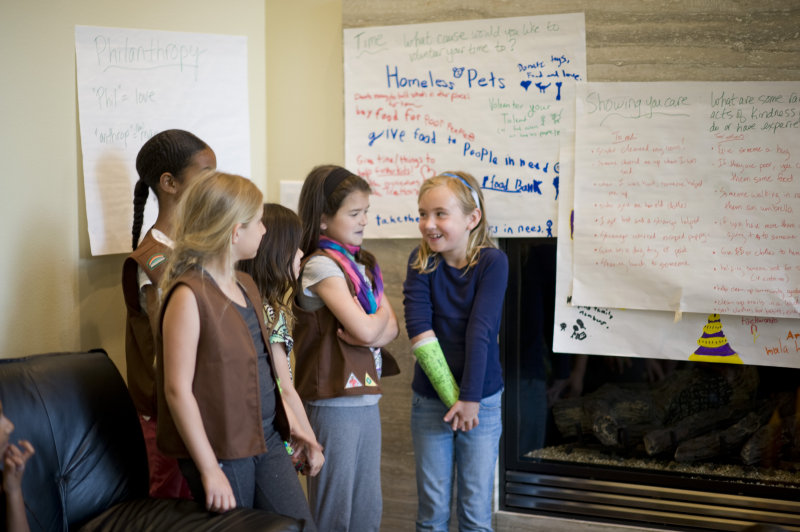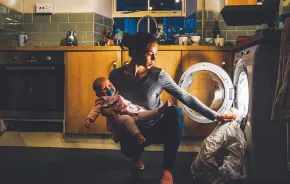
Not too long ago, my 11-year old daughter, Amy, and I showed up at Allison O’Mahoney’s house in Bellevue, just east of Seattle, on a beautiful Sunday afternoon.
Soon after we arrived, the house started coming alive with the boundless energy of 7- and 8-year-old girls from the Open Window School's second grade Brownie Girl Scouts Troop. O’Mahoney had read my blog and asked if I could chat with the girls about philanthropy.
During the hour we spent together, the girls and I explored three topics:
What is philanthropy?
I asked the girls if they knew what this word meant, and they said, “giving to others, giving to the community.” I told them this is exactly what Girl Scouts do and reminded them that the mission of the Girl Scouts is to build “girls of courage, confidence, and character, who make the world a better place.”
Being a bibliophile, I love words, so I asked them, “Did you know the root ‘phil’ in philanthropy means ‘love’ and the root ‘anthro’ means ‘(hu)man’? So the word philanthropy literally means love of people.”
And then I got carried away. I asked them to give me examples of other words with these roots.
Blank stares.
That was probably a little too complex for 7–8-year-olds.
(Answer: philosopher, anglophile, anthropology, Philip—lover of horses.)
We divided up into groups, where the girls brainstormed four ways to demonstrate philanthropy:
Giving your time: Volunteer for a cause you are passionate about. The girls are all interested in helping homeless pets. In fact, while they were there, one of their activities was making some dog pull toys to donate to shelters.
Giving your treasure: Donate money to your favorite cause. The girls brainstormed ways to raise money for the pet shelters: pet sitting and walking dogs, selling lemonade, making pet toys, doing chores, having a bake sale, gardening people’s weeds, putting on a show, selling your old car and having a garage sale.
Using your talent: Offer your skills to a cause. Examples: Play piano or drums at a fundraiser, cleaning for others (apparently these girls are good at cleaning!), gardening, art and cooking for others.
Show that you care: Practicing random acts of kindness. Examples of neat things the girls experienced: "My sister cleaned my room," "someone cheered me up when I was sad," "someone helped me up when I was hurt," "I got lost and a stranger helped me," "a stranger returned an escaped puppy," "someone gave me a dog toy at a park."
“A random act of kindness could be when it is raining and you give someone an umbrella.”
— A Girl Scout from Open Window School Second Grade Brownie Girl Scouts Troop
When I asked for examples of what the girls could do as a random act of kindness, 11-year-old Sydney Vernon , whose little sister was in the troop, suggested, “You could write poetry to make people feel better.”
I hadn’t experienced a memorable random act of kindness in a while, but a week after our program, my kids and I were at our neighborhood park playing after dinner, enjoying the last hour of daylight. Someone I had been chatting with left briefly and soon returned with Cupcake Royale cupcakes. I was very touched by that gesture, and the kids were wildly pleased.
The girls took turns drawing out an item from a bag and stating whether she would want or need it. But before we started I explained to them there was no right or wrong answer and that everyone can have her own opinion.
Distinguishing wants vs. needs
The first item that was drawn was a plain gray shirt. The girl who picked it said she would need it. When I asked her why, she responded that people needed clothes to survive.
“Okay,” I said, smiling. “This is kind of a plain shirt. What if I had a shirt that had ... ” and I looked around the room and spotted someone wearing sequins, " ... a really pretty pattern with sequins? Would you want it or need it?” Most of the girls said they would want it because it was pretty. I explained that there are some people who can’t afford to buy pretty clothes even though they want them.
Other examples of items in the bag:
Books: We need to learn to read so that we can get an education and get a job.
Jewelry: We want jewelry! It is pretty and makes us feel nice. But we really don’t need it.
Food: We need food in order to survive! “But do you want an apple versus chocolate pudding?” I asked and the girls smiled and admitted sugary treats were more tempting. We talked about how some foods are cheaper and not as healthy, and that some people cannot afford healthy options.
When I drew out an iPod, every girl exclaimed, “Want!” And one girl said, “I need it because it helps me to be entertained.” When I gently probed her, she admitted that she didn’t need an iPod to be entertained and that there were other ways to entertain herself.
Creating alternative traditions for giving around birthdays and holidays
“So we know that when our birthdays or the holidays come around, we like to get presents, right?” I asked.
A resounding “Yes!”
But Kaia Bui, 7, shook her head.
“Tell me what you are thinking,” I said.
“My parents donate to an organization on my birthday,” she said.
I later followed up with her mom, Tabatha Bui, who said, “We have made a decision as a family that our girls would receive presents from family ... we have asked friends to donate to a charity instead of giving presents. We just feel like we are so lucky and have so many material things ... our kids were getting so many gifts they wouldn't even use.”
I asked the girls, "What if we made birthdays and holidays about giving, rather than receiving, what would that look like?" I reminded them they will always get presents from their families, because they are very special.
I shared the example of the eight-day Hannukah calendar my family does every year when we design activities for each day of Hannukah. Rather than the focus of each day being about receiving presents, we focus on experiences that let us spend quality time together. We go ice skating, watch movies, make latkes (potato pancakes), write love notes (and here there is lots of eye rolling from my daughter, Amy) and when we get our act together, we try to volunteer or do some sort of service project.
The girls came up with some great examples and among my favorites were: Help friends/neighbors out, reuse and recycle garbage, clean for others, help sick people and collect food to make someone a meal.
 I loved talking to kids of this age. It was great having my daughter there, assisting me with taking notes and getting me materials. It really felt as though I was helping to challenge them into thinking about things a little differently. I got a confirmation of this a few weeks later, when Erin Vernon, Sydney’s mom, emailed me a letter Sydney had written to the Girl Scouts Headquarters.
I loved talking to kids of this age. It was great having my daughter there, assisting me with taking notes and getting me materials. It really felt as though I was helping to challenge them into thinking about things a little differently. I got a confirmation of this a few weeks later, when Erin Vernon, Sydney’s mom, emailed me a letter Sydney had written to the Girl Scouts Headquarters.
“I noticed that the [Philanthropy] badges were green with dollar signs on them. As I said above, we had learned that philanthropy means 'love of mankind' and that you don’t have to be wealthy to be a philanthropist. I think the badge was saying that, yes, philanthropy does have to do with money. Could you change the Philanthropy badge to represent helping people instead of money? You could replace dollar signs with hearts, maybe, or pictures of people doing random acts of kindness.”
You can read the full letter here.









